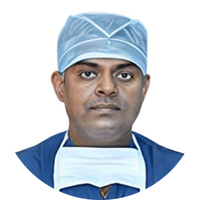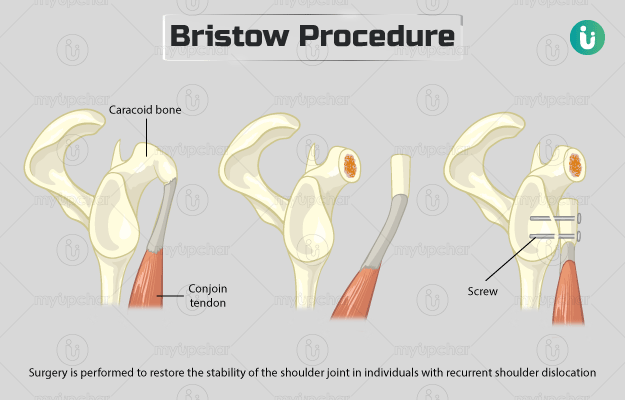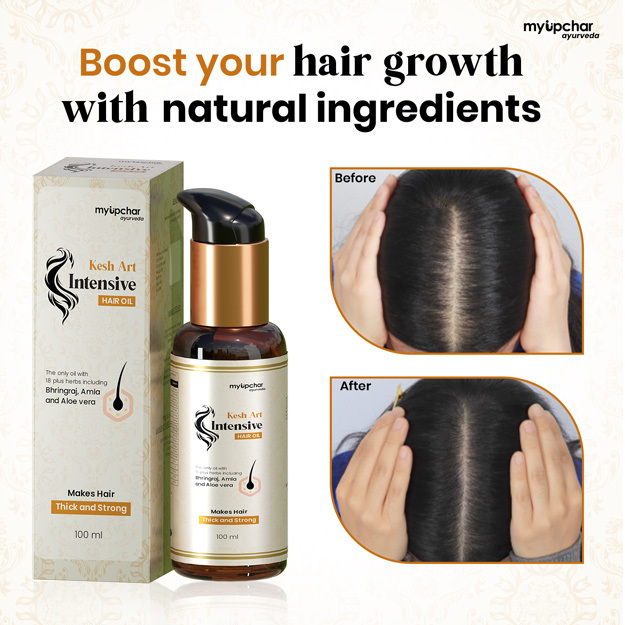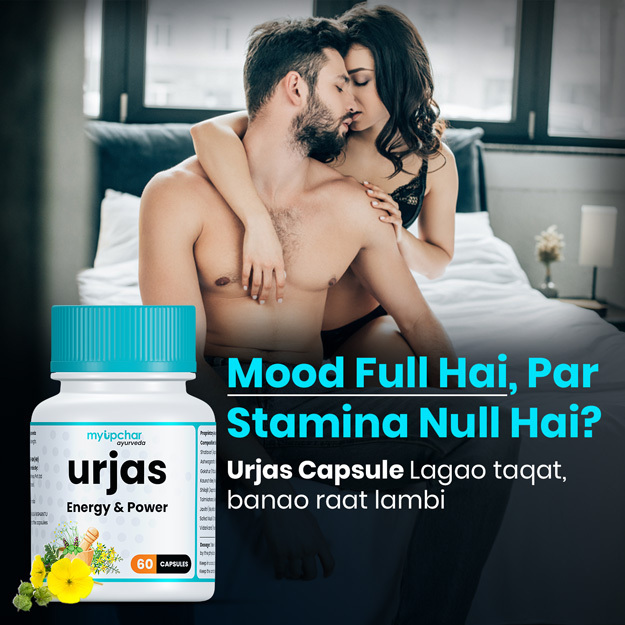Summary
Bristow procedure is performed in individuals with recurrent anterior shoulder instability that does not respond to non-surgical options. The condition reduces the range of motion of the affected shoulder joint and causes pain or swelling. During the surgery, the surgeon uses a bone cutter to cut a piece of bone from the scapula (shoulder blade) and stitch it to the front of the scapula, near the joint. You will need to wear a sling in the operated arm for a few weeks after the surgery until the wound heals. You may also need to visit a physiotherapist who will teach you exercises to improve the mobility of the operated shoulder.
- What is Bristow procedure?
- Why is Bristow procedure recommended?
- Who can and cannot get a Bristow procedure?
- What preparations are needed before a Bristow procedure?
- How is Bristow procedure done?
- How to care for yourself after Bristow procedure?
- What are the possible complications/risks of Bristow procedure?
- When to follow up with your doctor after Bristow procedure?
What is Bristow procedure?
Bristow procedure is a surgery performed to restore the stability of the shoulder joint in individuals with recurrent shoulder dislocation.
The shoulder joint consists of three bones, the clavicle (collarbone), scapula (shoulder blade), and humerus (upper arm bone). It is a ball-and-socket type of joint in which the head (ball) of the humerus fits into the rounded shallow cavity (socket) of the scapula. Since the socket is shallow, the joint depends on external tissues to keep the head of the humerus and other components in position. Rotator cuff is one such external tissue, which consists of a combination of muscles and connective tissues that encircle the ball of the bone and attach it to the shoulder blade. The rotator cuff keeps the ball of the humerus centred inside the socket.
However, since the shoulder joint is the most mobile joint in the body, it is prone to injuries and dislocation, especially in young adults who participate in contact sports. Normally, when the ball of the upper arm bone gets dislocated, the muscles and other tissues surrounding the joint pull the humerus back into its original position. Though this can sometimes damage or erode the ball part of the joint, increasing the chances of recurrent dislocation. Bristow procedure is performed in such cases to keep the shoulder joint from dislocating over and again. During the procedure, a small part of the bone from the shoulder blade is cut and fixed in front of the socket, close to the joint, to prevent dislocation. The procedure was originally developed in 1958. Since then, various modifications of the Bristow procedure have been developed.
Why is Bristow procedure recommended?
The surgery is recommended in individuals with anterior shoulder instability that does not respond to non-surgical treatments. Symptoms of the condition include:
- Pain
- Bruising
- Swelling
- Reduced range of movement of the shoulder joint
- A feeling as if the shoulder joint has come out of its socket, especially during certain activities like throwing a ball
What preparations are needed before a Bristow procedure?
Your surgeon will ask you to visit the hospital a few days prior to the surgery for a preoperative consultation, wherein you will be required to share the following details:
- Medical conditions (past and current)
- History of anaesthesia
- Allergies (If you have any)
- List of medicines, including herbs, vitamins, and over-the-counter medications
- Pregnancy status
The surgeon may ask you to undergo some of the following tests to confirm your diagnosis and make sure that you are an eligible candidate for the surgery:
- Blood tests
- Urine test
- Pregnancy test
- X-ray
- Computed tomography (CT) scan
- Magnetic resonance imaging (MRI) scan
In addition, the surgeon will provide you with the following instructions to prepare for the surgery:
- Discontinue warfarin, ibuprofen, aspirin, or other blood-thinning medications a few days before the surgery.
- Stop smoking.
- Fasting may be recommended for a few hours prior to the surgery to prevent vomiting (risk of general anaesthesia) during the surgery.
- Inform the surgeon if you have flu, cold, or fever before the surgery.
- Bring loose, comfortable clothing to the hospital.
- Take a shower and remove all the body piercings, make-up, and nail polish before you arrive at the hospital on the scheduled day of the surgery.
- Arrange a family member, friend, or a responsible adult to drive you home after the surgery.
- You will have to sign an approval form if you agree to the procedure.
How is Bristow procedure done?
Once you reach the hospital, the medical staff will ask you to undress and wear a hospital gown. They will connect an intravenous (IV) drip to your arm to supply essential medicines and fluids during the surgery. The procedure involves the following:
- You will be given one of the following types of anaesthesia:
- General anaesthesia (a medicine to put you in a deep sleep).
- General anaesthesia with a nerve block (a medicine to numb the nerves around the shoulder)
- Nerve block along with a light sedative.
- The surgeon will make an incision (cut) over your shoulder joint that needs to be operated on.
- He/she will cut a part of the coracoid process (a piece of the bone in the front of the scapula) with a bone cutter and stitch it in place in front of your scapula, adjacent to the joint.
- Once the bone piece is in place, the surgeon will close the cut on your skin using stitches and cover the operated area with a dressing.
You may feel tired, groggy, or restless and experience dry mouth or sore throat when you wake up after the surgery. These are side effects of general anaesthesia that usually fade away within a few hours. The nurse will make you wear a sling that will protect your shoulder joint during the healing process. You will need to wear the sling for about two to six weeks.
A physiotherapist will give you instructions to manage your sling and teach you some exercises to help keep your hand, elbow, and shoulder moving. A nurse will give you medicines to control the pain that you experience after the surgery. The surgeon will discharge you after you have recovered from the effects of anaesthesia, your pain is controlled, and if you are able to manage your sling. You will most likely be discharged on the same day of the surgery.
How to care for yourself after Bristow procedure?
Your surgeon will provide the following instructions to care for the surgical wound at home after Bristow procedure:
- Follow the instructions given by the physiotherapist to manage your sling since you may need to remove it to wash the area of surgery and change the dressing. Some of the instructions that you may be provided with will include:
- Rest the operated arm on a pillow while removing the sling.
- Do not remove the sling while sleeping. Lie on the opposite side of the operated shoulder. You can keep a pillow on each side of your body while sleeping to avoid rolling over.
- If you prefer sleeping on your back, keep a pillow under the elbow on the operated side.
- Take the prescribed medicines as directed by the surgeon.
- Keep the surgical site clean and dry. The surgeon will inform you when you can resume taking showers. However, you should avoid soaking the operated shoulder in a hot tub, bathtub, or swimming pool until the wound has healed completely.
- Avoid lifting objects for at least four to six weeks.
- Consult with the surgeon or physiotherapist before you decide to resume driving.
- You can resume your daily activities comfortably by six to 12 weeks after the surgery.
When to see the doctor?
Contact the surgeon if you experience any of the following after discharge from the hospital:
- Body temperature greater than 101oF (38.3oC)
- Swelling in the operated arm
- Loss of sensation or tingling in the hand or fingers on the operated side
- Redness, pain, bleeding, or discharge from the surgical site
What are the possible complications/risks of Bristow procedure?
The potential complications/risks associated with the surgery include:
- Injury to a nerve or blood vessels at the operated site
- Displacement of the stitched corticoid process
- Loss of external rotation
- Instability (anterior/posterior) in the operated shoulder
- Risks of general anaesthesia such as lung infection, stroke, and confusion
- Side effects of nerve block such as flushing of face and drooping of eyelids
When to follow up with your doctor after Bristow procedure?
You will have a follow-up appointment after about 10 days to get the stitches removed. You may need to see a physiotherapist once the sling is removed to learn exercises that will improve the mobility of the operated shoulder and help you return to normal activities.
Disclaimer: The above information is provided purely from an educational point of view and is in no way a substitute for medical advice by a qualified doctor.
Surgery Cost In Your City
Doctors for Bristow Procedure

Dr. Manoj Kumar S
Orthopedics
8 Years of Experience

Dr. Ankur Saurav
Orthopedics
20 Years of Experience

Dr. Pritish Singh
Orthopedics
12 Years of Experience

Dr. Vikas Patel
Orthopedics
6 Years of Experience
References
- Cowling PD, Akhtar MA, Liow RY. What is a Bristow-Latarjet procedure? A review of the described operative techniques and outcomes. Bone Joint J. 2016 Sep;98-B(9):1208-14. PMID: 27587522.
- Orthoinfo [internet]. American Academy of Orthopaedic Surgeons. Rosemont. IL. US; Shoulder Pain and Common Shoulder Problems.
- Johns Hopkins Medicine [Internet]. The Johns Hopkins University, The Johns Hopkins Hospital, and Johns Hopkins Health System; Shoulder Instability
- Arthritis Foundation [Internet]. Georgia. Australia; Shoulder Anatomy
- Sherwood Forest Hospitals [Internet]. NHS Foundation Trust. National Health Service. UK; Bristow-Latarjet Operation
- Srinivasan S, Pandey R. Current Concepts in the Management of Shoulder Instability. Indian J Orthop. 2017 Sep-Oct. 51 (5):524-528. PMID: 28966375.
- Lynch JR, Clinton JM, Dewing CB, Warme WJ, Matsen FA 3rd. Treatment of osseous defects associated with anterior shoulder instability. J Shoulder Elbow Surg. 2009 Mar-Apr. 18 (2):317-28. PMID: 19218054.
- National Health Service [Internet]. UK; Having an operation (surgery)
- Hernandez A, Sherwood ER. Anesthesiology principles, pain management, and conscious sedation. In: Townsend CM Jr, Beauchamp RD, Evers BM, Mattox KL, eds. Sabiston Textbook of Surgery. 20th ed. Philadelphia, PA: Elsevier; 2017:chap 14
- Mitchell EI, Murphy FL, Wyche MQ, Torg JS. Interscalene brachial plexus block anesthesia for the modified Bristow procedure. Am J Sports Med. 1982 Mar-Apr. 10 (2):79-82. PMID: 7081530.
- The Rotherham NHS Foundation Trust [Internet]. National Health Service. UK; Interscalene brachial plexus block for shoulder surgery
- Edwards TB, Morris BJ. Rehabilitation after shoulder arthroplasty. In: Edwards TB, Morris BJ, eds. Shoulder Arthroplasty. 2nd ed. Philadelphia, PA: Elsevier; 2019:chap 43
- Cordasco FA. Shoulder arthroscopy. In: Rockwood CA, Matsen FA, Wirth MA, Lippitt SB, Fehringer EV, Sperling JW, eds. Rockwood and Matsen’s The Shoulder. 5th ed. Philadelphia, PA: Elsevier; 2017:chap 15.
- Throckmorton TW. Shoulder and elbow arthroplasty. In: Azar FM, Beaty JH, Canale ST, eds. Campbell’s Operative Orthopaedics. 13th ed. Philadelphia, PA: Elsevier; 2017:chap 12.
- Young DC, Rockwood CA Jr. Complications of a failed Bristow procedure and their management. J Bone Joint Surg Am. 1991 Aug. 73 (7):969-81.PMID: 1874783.
- Griesser MJ, Harris JD, McCoy BW, Hussain WM, Jones MH, Bishop JY, et al. Complications and re-operations after Bristow-Latarjet shoulder stabilization: a systematic review. J Shoulder Elbow Surg. 2013 Feb. 22 (2):286-92. PMID: 23352473.















